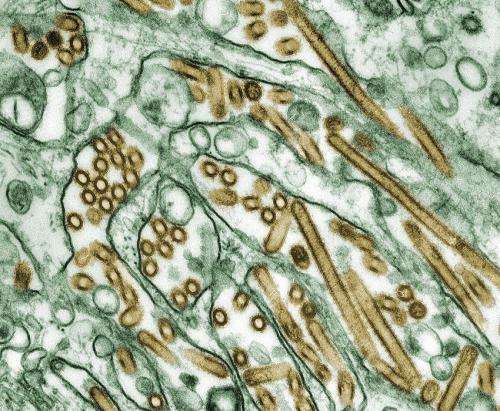This article has been reviewed according to Science X's editorial process and policies. Editors have highlighted the following attributes while ensuring the content's credibility:
fact-checked
peer-reviewed publication
trusted source
proofread
H5 influenza vaccines: What needs to be done to reduce the risk of a pandemic

As the global threat of H5N1 influenza looms with outbreaks across species and continents including the U.S., three international vaccine and public health experts say it is time to fully resource and support a robust strategy to address this and future potential pandemic influenza threats, including to consider voluntary vaccination for those now at exposure risk.
"At this critical juncture, decisions about vaccine development, stockpiling, and deployment will shape our ability to respond to immediate and future pandemic risks," writes Jesse Goodman, MD, Ph.D.; Rick A. Bright, Ph.D.; and Nicole Lurie, MD, MSPH, in a JAMA Viewpoint published Sept. 4.
The current outbreak of H5N1 in North America has infected poultry, cows, wild birds, and marine and terrestrial mammals, along with at least 13 humans, primarily on dairy and poultry farms. No human-to-human transmission has been reported.
"It is highly concerning that this H5N1 strain, compared with prior ones, has had unprecedented spread among mammals" says Goodman. "Although human cases have so far been relatively mild, the threat of a pandemic is real, given the virus's widespread and continued presence close to humans and its potential to reassort with human influenza viruses or mutate to acquire the ability to transmit among humans."
Goodman is a professor of medicine at Georgetown University School of Medicine and former FDA Chief Scientist; Bright is a principal with Bright Global Health and former Deputy Assistant Secretary for Preparedness and Response and the Director of the Biomedical Advanced Research and Development Authority (BARDA); and Lurie is executive director for Preparedness and Response at the Coalition for Epidemic Preparedness Innovations and Director of CEPI-US and former Assistant Secretary for Preparedness and Response at the U.S. Department of Health and Human Services.
Focusing on vaccines, Goodman and his colleagues outline short, medium and long-term actions to combat the H5N1 risk: protect exposed individuals and reduce pandemic risk; refresh vaccine stockpiles and enhance capacity; lay the groundwork for mitigating future threats.
Short term
The authors note that the U.S. government is readying 4.8 million doses of stockpiled H5N8 vaccine, which is expected to offer cross-protection against current H5N1 strains.
As a short term consideration, the writers say, "Provided adequate supporting data and regulatory review, stockpiled vaccine(s) should be offered voluntarily to individuals at exposure risk." Those at risk include farm workers with close contact to animals.
Medium term
In the medium term, the authors stress the importance of ensuring that vaccine stockpiles are refreshed with doses well matched to circulating viruses. The goal is to ensure that at least 20 million individuals, particularly critical workforce members, can be rapidly immunized in the event of a pandemic.
In addition, the public health trio call for taking steps now to ready and enhance global pandemic influenza vaccine development and production capacity, including evaluating the potential of mRNA vaccines, which offer faster and more scalable manufacturing processes.
Long term
Looking further ahead, Goodman and his colleagues advocate for the exploration of pre-pandemic immunization strategies. This could involve vaccinating high-risk groups during interpandemic periods to build population immunity against potential pandemic strains, a strategy that, while unproven, could significantly mitigate the impact of future pandemics.
Finally, the authors call on elected officials, governments, global partners and the private sector to address H5N1 and other pandemic influenza threats through a comprehensive strategy for human and animal health encompassing pandemic vaccines as well as diagnostics, therapies, and non-pharmaceutical interventions.
They note that the convergence of health and agricultural concerns, including protecting workers, farm animals, and the economy, presents an opportunity to transcend divides.
They conclude, "The time for decisive action is not when a pandemic strikes, but today, while we have the opportunity."
More information: H5 Influenza Vaccines—Moving Forward Against Pandemic Threats, JAMA (2024). jamanetwork.com/journals/jama/ … 1001/jama.2024.17488




















